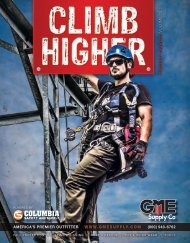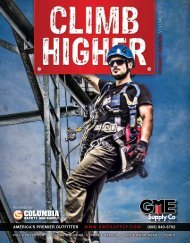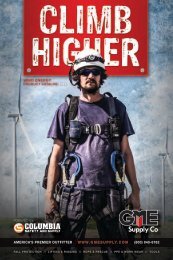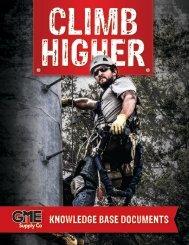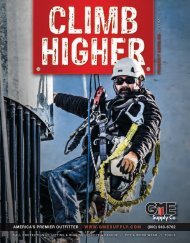GME Supply Catalog Version 19.1
GME Supply is North America's premier outfitter of fall protection, safety equipment, and gear for at-height workers, industry, and construction.
GME Supply is North America's premier outfitter of fall protection, safety equipment, and gear for at-height workers, industry, and construction.
Create successful ePaper yourself
Turn your PDF publications into a flip-book with our unique Google optimized e-Paper software.
RESPIRATOR 101<br />
When working in hazardous environments or with<br />
hazardous materials, taking every precaution to<br />
protect your lungs is essential. Respirators are<br />
designed to filter out specific particles, chemicals,<br />
or vapors, to prevent them from causing injury,<br />
illness, or worse.<br />
WHAT ARE THE<br />
HAZARDS?<br />
Determining hazards present in a particular job is<br />
the first step to selecting a respirator. Each type<br />
of respirator has features designed to mitigate the<br />
risk associated with various airborne irritants.<br />
SOME COMMON HAZARDS ARE:<br />
Particulates - silica, hazardous dust and fibers<br />
Welfume - stainless and galvanized steel<br />
Lead<br />
Asbestos/Mold<br />
Bleach/Ammonia - General cleaning products<br />
Pesticides/Insecticides<br />
Solvents - Water based latex<br />
Chemicals - Sulfur dioxide, chlorine, ammonia<br />
While this is not a complete guide for every<br />
hazard you might encounter, it cannot be stressed<br />
enough the importance of matching the respirator<br />
and filter with the hazards present.<br />
ASSESS THE SITUATION<br />
Next, the jobsite should be assessed for overall<br />
employee exposure. Do all workers on the site<br />
need respiratory protection or just those in the<br />
immediate area of the hazard?<br />
Air quality is typically measured in parts per<br />
million (ppm) or milligrams per cubic meter of<br />
air (mg/m3). Specific guidelines are outlined in<br />
OSHA’s Respiratory Protection Standard 29 CFR<br />
1910.134.<br />
LEVEL OF PROTECTION<br />
Depending on the type of hazard, and level<br />
of exposure, you may need a specific style of<br />
respirator.<br />
THERE ARE THREE MAIN TYPES:<br />
Disposable, Half Mask, and Full Face.<br />
Disposable respirators are the most basic form<br />
and provide short-term protection. They may not<br />
be suitable for all types of hazards.<br />
Half mask and full face respirators are usually<br />
reusable and provide more protection. They also<br />
add the convenience of having replaceable filters<br />
to swap out for different protection needs.<br />
For even more hazardous environments, there<br />
are also supplied air systems which completely<br />
supplement the air in the work environment for<br />
clean, safe air.<br />
FILTERS<br />
The filter of the respirator allows air to flow<br />
through, but blocks the hazards. Disposable<br />
respirators come with a built in filter, where half<br />
and full face respirators have removable filters<br />
which can be changed based on the hazard, or<br />
replaced when they become worn out.<br />
FILTERS CAN<br />
HAVE 1 OF 3<br />
LETTER CLASS<br />
RATINGS:<br />
Class N - Not oil resistant<br />
Class R - Resistant to oil<br />
Class P - Oil proof<br />
They also use a 3 number rating system, based<br />
on how well they filter particles measuring 0.3<br />
microns or larger in diameter.<br />
95 - Filters 95% of all particles<br />
99 - Filters 99% of all particles<br />
100 - Filters 100% of all particles.<br />
These two filter classes are typically noted in this<br />
form: N95, P100, etc.<br />
PERSONAL SAFETY // HAND PROTECTION<br />
DISPOSABLE<br />
HALF MASK<br />
FIT<br />
When wearing a respirator, it is essential that it<br />
fit correctly. A user should be fit to ensure that<br />
they have selected the proper size and style of<br />
respirator. This test should be administered by a<br />
trained person, and repeated regularly.<br />
A seal check should be performed each time the<br />
respirator is donned, to check for gaps that allow<br />
air to pass between the face and the face seal.<br />
STANDARDS<br />
OSHA only allows respirators approved by the<br />
National Institute for Occupational Safety and<br />
Health (NIOSH) for workplace use.<br />
(800) 940-6762<br />
163












